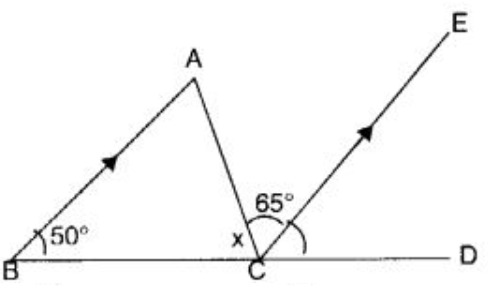Practicing the Class 7 Maths MCQ Questions for The Triangles and its Properties with Answers aids students to try the board exams with full confidence. We try our high-quality to offer you numerous Objective Questions of CBSE Class 7 Maths so you can score maximum marks withinside the examination.
Solving those MCQ Questions of Class 7 Maths will assist you to be acquainted with the type of questions and cover the complete syllabus in a clever way. Practice on an everyday basis so you can try the Multiple Choice Questions of Class 7 Maths without difficulty. This will assist them to without difficulty clear up the MCQ questions in the examination paper. It takes plenty of analytical & logical concepts to successfully clear up Class 7 Maths goal problems. This may be carried out through our CBSE Board Class 7 Maths Objective Style Questions with solutions for all chapters.
Practice MCQ Questions for Class 7 Maths
1. If all the three sides of a triangle are equal, the triangle is called
(a) equilateral
(b) right-angled
(c) isosceles
(d) scalene.
2. If all the angles of a triangle are acute, the triangle is called
(a) obtuse-angled
(b) acute-angled
(c) right-angled
(d) none of these
3. If one angle of a triangle measures 90°, the triangle is called
(a) acute-angled
(b) obtuse-angled
(c) right-angled
(d) none of these
4. How many medians can a triangle have?
(a) 1
(b) 2
(c) 3
(d) 4
5. If p: The total measure of the three angles of a triangle is 180º and q: Sum of the length of any two sides of a triangle is less than the length of the third side, then which of the following options hold?
(a) Both p and q are true
(b) p is true and q is false
(c) p is false and q is true
(d) Both p and q are false
6. The measure of each angle of an equilateral triangle is
(a) 30º
(b) 45º
(c) 90º
(d) 60º
7. Two angles of a triangle measure 90º and 30º. The measure of the third angle is
(a) 90º
(b) 30º
(c) 60º
(d) 120º
8. The ratio of the measures of the three angles of a triangle is 2 : 3 : 4. The measure of the largest angle is
(a) 80º
(b) 60º
(c) 40º
(d) 180º
9. In the following figure, m || QR. Then, the measure of ∠QPR is

(a) 80º
(b) 85º
(c) 75º
(d) 70º
10. In the following figure, ∆ ABC is an equilateral triangle. Find ∠x.

(a) 30º
(b) 45º
(c) 60º
(d) 90º
11. In the following figure, find ∠ x and ∠ y, if ∠x – ∠y – 10º

(a) 65º, 55º
(b) 55º, 45º
(c) 45º, 35º
(d) 60º, 60º
12. In the following figure, one angle of triangle ABC is 40º. If the difference of the other two angles is 30°, find the larger of the other two angles.

(a) 85º
(b) 80º
(c) 75º
(d) 70º
13. In which case of the following lengths of sides of a triangle, is it possible to draw a triangle?
(а) 3 cm, 4 cm, 7 cm
(b) 2 cm, 3 cm, 7 cm
(c) 3 cm, 4 cm, 5 cm
(d) 3 cm, 3 cm, 7 cm
14. Which of the following cannot be the sides of a right triangle?
(а) 2 cm, 2 cm, 4 cm
(b) 5 cm, 12 cm, 13 cm
(c) 6 cm, 8 cm, 10 cm
(d) 3 cm, 4 cm, 5 cm
15. Find angle x in the following figure:

(a) 90°
(b) 80°
(c) 95°
(d) 100°
16. Find angle x in the following figure:

(a) 58°
(b) 59°
(c) 57°
(d) 56°
17. A triangle has how many sides :
(a) three
(b) five
(c) four
(d) None of these
18. If two sides of a triangle are added then the result is :
(a) greater than third
(b) less than third
(c) equal to third
(d) none of these
19. Vikash wants to plant a flower on the ground in the form of a rhombus. The diagonals of the rhombus measure 42 cm and 56 cm. Find the perimeter of the field.
(a) 150 cm
(b) 140 cm
(c) 130cm
(d) 120cm
20. Which is the longest side of a right triangle?
(a) Base
(b) Perpendicular
(c) Hypotenuse
(d) None of these
21. If two sides of a triangle are not equal the triangle is called
(a) scalene
(b) isosceles
(c) equilateral
(d) right-angled
22. ABC is an isosceles triangle with AB = AC and AD is altitude, then ____.
(a) ∠B>∠C
(b) ∠B<∠C
(c) ∠B=∠C
(d) None of these
23. In a ΔABC, which of the given condition holds?
(a) AB−BC>CA
(b) AB+BC<CA
(c) AB−BC<CA
(d) AB+CA<BC
24. Maximum number of possible obtuse angles in a triangle is:
(a) 0
(b) 1
(c) 2
(d) 3
25. In the following figure, find x if BA || CE.

(a) 60°
(b) 40°
(c) 45°
(d) 65°